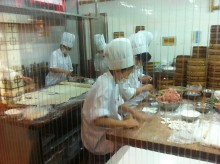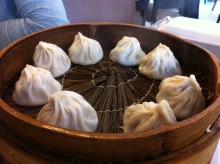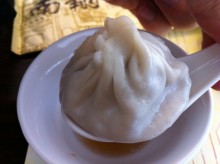
Just across from Yang’s new location in the new mall on Wujiang Street is another place that serves up xiaolongbao (soup dumplings). It’s called Nan Xiang Steamed Bun Restaurant and cooks them up in the original steamed way. Nan Xiang is actually the part of Shanghai where xiaolongbao originated and you can still find the original in its location near the Yu Garden, but the line is always crazy-long, so when I saw the Nan Xiang restaurant right next to Yang’s, I figured I would give them a taste.

Similar to Yang’s, there is a clear window that allows any passerby to see the magic of dumpling-making. But that’s pretty much where the similarities end. Nan Xiang is more of a sit-down restaurant and because of this, there isn’t a line out the door to draw people in. We were seated pretty quickly and knew what we wanted before looking at the menu. We ordered eight dumplings (their smallest set) and a bit of green tea.

The dumplings came out pretty quickly and were served in an old-fashioned bamboo steamer – presumably the one they were cooked in. The steamed xiaolongbao are smaller than their fried counterpart, so consuming eight between the two of us didn’t seem like much of a daunting task. Picking these up with chopsticks was much easier than the fried ones, so losing soup wasn’t a big concern. The method for eating these is essentially the same as the other xiaolongbao, but with the added bonus of being able to put the dumpling into a spoon after the initial removal from the steamer.

I bit off a small part and slurped out the soup. This is the best way to eat xiaolongbao, because putting the whole thing in your mouth and biting will unleash a scalding soup and leave you with a burnt mouth. Anyway, the soup was nothing short of delicious and although the flavor was slightly different from Yang’s, neither was exactly better. Once the dumpling had been slurped dry, it was time to take on the meat and dough. I found that the meat of the steamed dumpling was a little more flavorful than when fried, but I did miss the crunchiness of the dough that only frying could provide. Although fundamentally the same, steamed and fried xiaolongbao were certainly different enough to merit trying both.
Ultimately I enjoyed the fried dumpling better, but Nan Xiang’s steamed style wasn’t exactly a slacker. And hey, if weren’t for these traditional steamed dumplings, the fried dumplings could never have come to be.